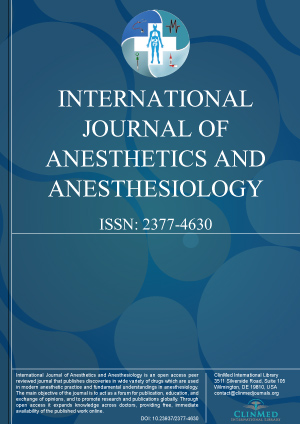Open Access DOI:10.23937/2377-4630/1410176
Demographic Profile and Incidence of Residual Neuromuscular Blockade with the Use of Rocuronium and Sugammadex in Oncological Patients in the Post-Anesthetic Recovery Room
Donn-Thell Frewyd Sawntzy Junior, Antônio Roberto Marques Lima, Caroline Olinda de Souza Pitoli, Gaya Amanda Said Barbosa Lima, Mariam Lidemys Marin Montejo, Renata Larissa de Araújo Fernandes, André Renato Moura Barroso, Ivandete Coelho Pereira Pimentel and Mirlane Guimarães de Melo Cardoso
Article Type: Original Article | First Published: 2024/03/25
Neuromuscular blockers are drugs that provide safety for general anesthesia. However, when there is no spontaneous and complete return of normal neuromuscular function in the postoperative period, residual neuromuscular blockade (RNMB) may occur, which has a significant impact on airway physiology, increasing the risks of respiratory complications, including hypoxemia. Sugammadex is an agent that reverses the neuromuscular blockade caused by rocuronium bromide through its selective encapsulation...
Open Access DOI:10.23937/2377-4630/1410175
Implementation of Hemodynamic Management with the Hypotension Prediction Index during Elective Open Abdominal Aortic Surgery: A Pilot Observational Report
Enrico Giustiniano, MD, Fulvio Nisi, MD1, Francesco Gambino, MD, Romina Aceto, MSc, Manuel Ignacio Garcia Monge, MD and Maurizio Cecconi, FRCA, FFICM, MD
Article Type: Clinical Observational Study | First Published: 2024/03/22
Intra-operative hypotension (IOH) is associated with a poor post-operative outcome. Consequently, it seems important to reduce the incidence of hypotensive events during anesthesia. The HemosphereTM (Edwards Lifescience Co., Irwin, CA, USA) platform provides the Hypotension Prediction Index (HPI), a predictive marker for a drop in blood pressure within a few minutes. We report the results of one year of application of a simple HPI-algorithm aiming at reducing the incidence of IOH in open abdomin...
Open Access DOI:10.23937/2377-4630/1410173
Anaesthetic Management in Glucose-6-Phosphate Dehydrogenase (G6PD) Deficiency Patient Posted for Total Knee Replacement: A Case Report
Medha Bhardwaj, MD, DNB, DM, Saurabh Mittal, MD, DNB, DM, Harsimran Kaur Buttar, MD and Gurjeet Khurana
Article Type: Case Report | First Published: 2024/03/01
Glucose-6-phosphate dehydrogenase (G6PD) deficiency is a most common hereditary genetic, X-linked defect of red blood cells (RBC) enzyme disorder in humans. Clinical manifestations commonly seen are neonatal jaundice, acute hemolytic or chronic non-spherocytic anemia. Acute hemolysis poses a perioperative challenge in management for anesthesiologists and the surgeons. Peripheral nerve block as well as general anaesthesia is a popular and safe anesthesia technique....
Open Access DOI:10.23937/2377-4630/1410171
A Questionnaire-Based Survey of Perioperative Utilisation of Ultrasound among Anaesthesiology Residents
Pharanitharan Natarajan and Chandini Kukanti
Article Type: Original Article | First Published: 2024/02/29
Ultrasonography (USG) is a resourceful tool in the perioperative period. A structured training curriculum during residency can enhance the utilisation of USG among residents. This cross-sectional online survey was conducted to evaluate the utilisation of USG in the perioperative period and to assess the adequacy of current training. It was found that although the availability of USG has increased, its use in the perioperative period is limited due to various factors such as time constraints. The...
Open Access DOI:10.23937/2377-4630/1410170
May Numbers be the Voice of Gods? - May Artificial Intelligence Replace Human Intelligence and Bring Man Back to the Future?
Enrico Giustiniano, MD and Fulvio Nisi, MD
Article Type: Editorial | First Published: 2024/01/19
Knowing the future has been a challenge for humans since the dawn of time. Divination or Mantics is an ancient practice based on the idea that humans could ask gods about the future, and it was practiced in two ways. First, a priest, directly in contact with the divinity, interpreted its objective signs. Second, the 'gods’ will manifest themselves in a more immediate way, through the words uttered by a human figure directly inspired by the god. In both cases, it was a leap of faith, with only ...
Open Access DOI:10.23937/2377-4630/1410169
Posterior Reversible Encephalopathy Syndrome (PRES): An Unusual Presentation
Geetika Duggal, Ruchika Kathuria and Vibha Mehta
Article Type: Editorial | First Published: 2024/01/19
The first patient, a 20-year-old woman who underwent a caesarean section under spinal anaesthesia complained of a headache immediately after surgery and experienced a generalised tonic-clonic seizure 4 hours later. Vitals remained stable. Supplemental oxygen, midazolam, magnesium sulphate, levetiracetam, mannitol, furosemide, and steroids were used to treat the patient. The results of a brain MRI showed subcortical vasogenic edoema suggestive with PRES and bilaterally symmetrical areas of altere...

